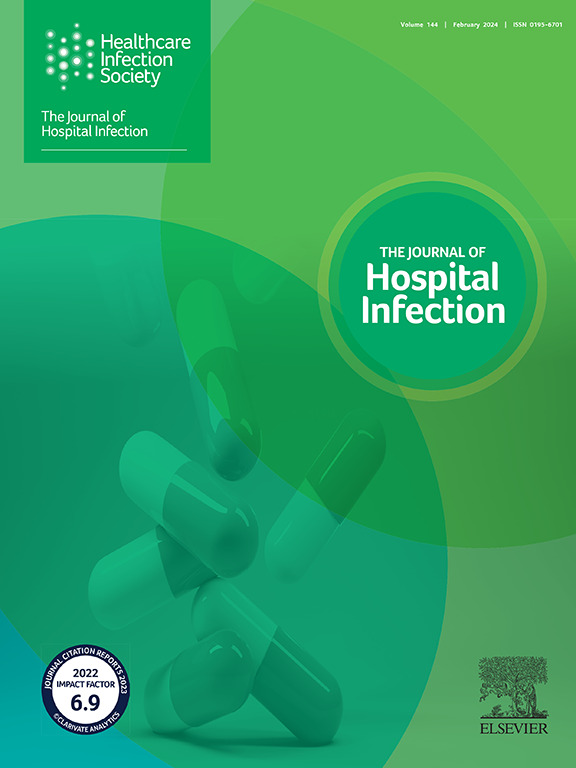一次性口腔护理套装对减少呼吸机相关性肺炎的影响。ICU患者:一项多中心研究。
IF 3.9
3区 医学
Q1 INFECTIOUS DISEASES
引用次数: 0
摘要
背景:呼吸机相关肺炎是机械通气患者中一种严重的医院相关感染。目的:评估一次性口腔护理套装在降低 VAP 发生率方面的效果,并评估 ICU 护士对其使用的看法:方法: 在 14 家三级医院的重症监护室开展了一项多中心研究。方法:在 14 家三级医院的重症监护病房开展了一项多中心研究,按照标准化口腔护理方案使用一次性口腔护理套装清洁患者的口腔。对使用口腔护理套装前后的 VAP 发生率和 VAP 抗生素治疗成本进行了比较。通过自填式问卷收集了重症监护病房护士对口腔护理套装的意见:结果:在使用口腔护理套装之前,在 34,731 个呼吸机日中有 269 例 VAP,每 1,000 个呼吸机日的 VAP 发生率为 7.74。治疗 VAP 的抗生素总费用为 5,137,622 泰铢。项目实施后,在 34,309 个呼吸机日中,VAP 病例减少到 182 例,每千个呼吸机日的 VAP 发生率为 5.30,显著降低了 31.52% (p < 0.05)。抗生素治疗费用也大幅下降至 2,101,940 泰铢(p < 0.05)。在接受调查的 220 名重症监护室护士中,96.3% 的人同意或非常同意口腔护理套装有助于预防医源性感染 (HAI)。超过 85% 的受访者表示口腔护理套装更易于使用、患者更舒适、更符合循证指南的要求:结论:在标准化口腔护理方案中使用一次性口腔护理套装可有效降低 VAP 发生率和相关成本。重症监护室护士对口腔护理套装的满意度很高,凸显了其在加强患者安全、提高指南依从性和降低医疗成本方面的潜力。建议将一次性口腔护理套装常规纳入机械通气患者的口腔护理方案。本文章由计算机程序翻译,如有差异,请以英文原文为准。
Impact of single-use oral care sets on reducing ventilator-associated pneumonia among intensive care unit patients: a multi-centre study
Background
Ventilator-associated pneumonia (VAP) is a serious hospital-associated infection among mechanically ventilated patients. Proper oral care is a critical intervention for reducing VAP incidence.
Aim
To evaluate the effectiveness of single-use oral care sets in reducing VAP incidence and assessing ICU nurses' perspectives on their use.
Methods
A multi-centre study was conducted in the ICUs of 14 tertiary-care hospitals. Single-use oral care sets were used for cleaning patients' oral cavities following a standardized oral care protocol. VAP rates and cost of VAP antibiotic treatment were compared before and after implementing the oral care sets. ICU nurses' opinions on the oral care sets were collected using a self-administered questionnaire.
Findings
Before implementing the oral care sets, there were 269 VAP cases over 34,731 ventilator-days, with a VAP rate of 7.74 per 1000 ventilator-days. The total antibiotic cost for VAP treatment was 5,137,622 Thai baht. After implementation, VAP cases decreased to 182 over 34,309 ventilator-days, with a significantly reduced VAP rate of 5.30 per 1000 ventilator-days – a 31.52% reduction (P<0.05). Antibiotic treatment costs also declined significantly to 2,101,940 Thai baht (P<0.05). Among 220 ICU nurses surveyed, 96.3% agreed or strongly agreed that the oral care sets helped prevent healthcare-associated infections (HAIs). Over 85% reported improved ease of use, increased patient comfort, and better adherence to evidence-based guidelines.
Conclusion
The use of single-use oral care sets within a standardized oral care protocol effectively reduces VAP incidence and associated costs. ICU nurses expressed high satisfaction with the oral care sets, highlighting their potential to enhance patient safety, improve adherence to guidelines, and reduce healthcare costs. Routine integration of single-use oral care sets into oral care protocols for mechanically ventilated patients is recommended.
求助全文
通过发布文献求助,成功后即可免费获取论文全文。
去求助
来源期刊

Journal of Hospital Infection
医学-传染病学
CiteScore
12.70
自引率
5.80%
发文量
271
审稿时长
19 days
期刊介绍:
The Journal of Hospital Infection is the editorially independent scientific publication of the Healthcare Infection Society. The aim of the Journal is to publish high quality research and information relating to infection prevention and control that is relevant to an international audience.
The Journal welcomes submissions that relate to all aspects of infection prevention and control in healthcare settings. This includes submissions that:
provide new insight into the epidemiology, surveillance, or prevention and control of healthcare-associated infections and antimicrobial resistance in healthcare settings;
provide new insight into cleaning, disinfection and decontamination;
provide new insight into the design of healthcare premises;
describe novel aspects of outbreaks of infection;
throw light on techniques for effective antimicrobial stewardship;
describe novel techniques (laboratory-based or point of care) for the detection of infection or antimicrobial resistance in the healthcare setting, particularly if these can be used to facilitate infection prevention and control;
improve understanding of the motivations of safe healthcare behaviour, or describe techniques for achieving behavioural and cultural change;
improve understanding of the use of IT systems in infection surveillance and prevention and control.
 求助内容:
求助内容: 应助结果提醒方式:
应助结果提醒方式:


